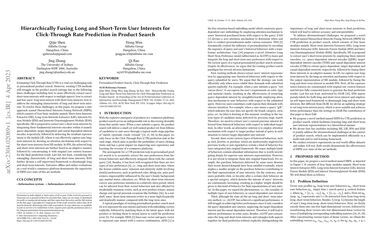Hierarchically Fusing Long and Short-Term User Interests for Click-Through Rate Prediction in Product Search
Estimating Click-Through Rate (CTR) is a vital yet challenging task in personalized product search. However, existing CTR methods still struggle in the product search settings due to the following three challenges including how to more effectively extract users' short-term interests with respect to multiple aspects, how to extract and fuse users' long-term interest with short-term interests, how to address the entangling characteristic of long and short-term interests. To resolve these challenges, in this paper, we propose a new approach named Hierarchical Interests Fusing Network (HIFN), which consists of four basic modules namely Short-term Interests Extractor (SIE), Long-term Interests Extractor (LIE), Interests Fusion Module (IFM) and Interests Disentanglement Module (IDM). Specifically, SIE is proposed to extract user's short-term interests by integrating three fundamental interests encoders within it namely query-dependent, target-dependent and causal-dependent interest encoder, respectively, followed by delivering the resultant representation to the module LIE, where it can effectively capture user long-term interests by devising an attention mechanism with respect to the short-term interests from SIE module. In IFM, the achieved long and short-term interests are further fused in an adaptive manner, followed by concatenating it with original raw context features for the final prediction result. Last but not least, considering the entangling characteristic of long and short-term interests, IDM further devises a self-supervised framework to disentangle long and short-term interests. Extensive offline and online evaluations on a real-world e-commerce platform demonstrate the superiority of HIFN over state-of-the-art methods.
PDF Abstract

